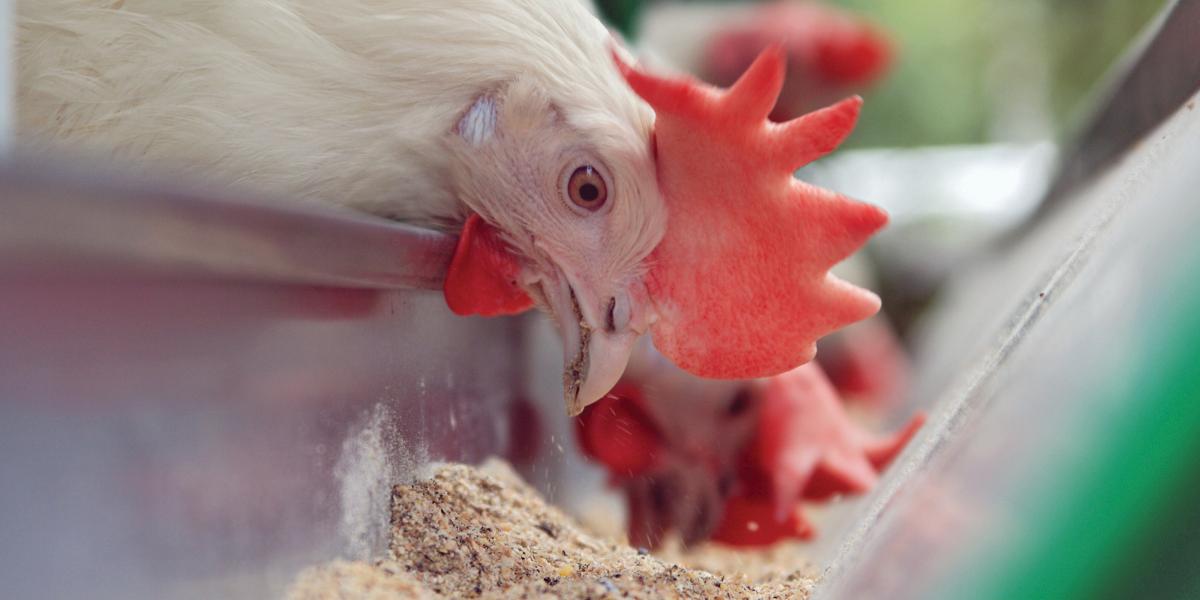Arsenic and Chicken Feed
Nobody puts arsenic on the shopping list. Yet most of us have bought chickens purposely and legally fed it. According to new research, this arsenic lives on not only in chicken waste (a familiar concern) but also in chicken meat.
Keeve Nachman, PhD ’06, MHS ’01, lead author of the study, hopes it will lend scientific muscle to efforts aimed at banning arsenic from poultry production.
Until July 2011, arsenic was a popular additive to chicken diets—enhancing growth, promoting pinker meat and combating parasites.
Today, the chemical’s fate hangs in limbo, says Nachman, who heads the Farming for the Future program at the Johns Hopkins Center for a Livable Future (CLF). After an FDA-conducted study found heightened levels of arsenic in chicken livers, Pfizer voluntarily halted sales of roxarsone (an organic form of arsenic) in the U.S.—though not abroad, Nachman notes. But the FDA didn’t go the further step of banning future use of roxarsone or other arsenic-based drugs.
Hoping to “close this gap,” Nachman and his colleagues set out to answer a simple, yet technically challenging, question: Does using roxarsone heighten levels of inorganic arsenic (the form that’s a well-known carcinogen) in chicken meat? It’s a question with implications both for roxarsone and for nitarsone, a similar arsenical drug that Pfizer continues to sell here.
The team’s work began with a nationwide shopping spree when roxarsone was still on the market. Collaborators bought 142 chickens in 10 U.S. cities, shipped them overnight in coolers to Baltimore, carefully prepared samples (testing raw and cooked samples from each chicken), freeze-dried them, and sent them to Austria for analysis by Kevin Francesconi, PhD, of the University of Graz, “one of the top metals chemists in the world,” says Nachman.
The results confirmed the team’s hypothesis: if a chicken ingests roxarsone, you’ll wind up with more carcinogenic arsenic in breast meat. The big surprise came from the cooked samples. “We didn’t think the concentrations would change,” says Nachman. “But it turns out that cooking increases inorganic arsenic, likely by degrading the roxarsone. The mean inorganic arsenic content of cooked conventional chickens was 1.8 micrograms per kilogram—three times that of cooked samples from chickens raised organically, according to the study published in May in Environmental Health Perspectives.
By the team’s calculations, eating chickens raised with arsenic rather than organic ones would result in additional (and unnecessary) exposures to inorganic arsenic. If arsenical drug usage were still a universal practice in domestic poultry production, the researchers estimated that the increase in arsenic exposures from eating chicken would result in approximately 124 lung and/or bladder cases in the U.S. each year.
The key word is “unnecessary.” People are exposed to arsenic through a wide variety of environmental and dietary pathways. Yet “in every other context,” says Nachman, “any residual arsenic that’s found in foods is the result of natural processes, historic pesticide use or unintended contamination.” But in the case of chicken meat, “a very simple decision” to ban arsenic-based drugs would eliminate the risk, Nachman says.
“We have needed this type of data for several years,” says Amy Sapkota, PhD ’05, MPH, an associate professor at the University of Maryland School of Public Health, who has received funding from CLF.
Now that the evidence is in, she adds, banning arsenic in chicken feed “seems like a no-brainer.”
